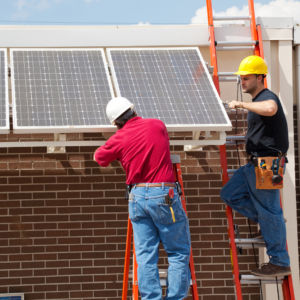In the end, the concerned letters and worried testimonies were all for naught. On Tuesday, President Trump issued his final decision on solar panel tariffs. Despite pleas from industry groups, the administration decided to impose 30 percent tariffs on imported crystalline silicon photovoltaic cells and panels in order to protect domestic manufacturers. According to the administration, the tariffs will remain in place for four years, with the rates gradually reducing over time. Although the decision was not what the solar industry had hoped for, the tariffs are unlikely to do more than slow the growth of solar energy, which has accelerated in the past few years.
The administration defended the tariffs, saying that they would help domestic manufacturers.
“The ITC found that U.S. producers had been seriously injured by imports and made several recommendations to the president,” said U.S. Trade Representative Robert Lighthizer.
“The president’s action makes clear again that the Trump administration will always defend American workers, farmers, ranchers, and businesses in this regard,” he continued.
However, other observers are worried that increased prices will hurt installations more than they will help manufacturers.
“There’s no doubt this decision will hurt U.S. manufacturing, not help it,” said Bill Vietas, president of RBI Solar. “The U.S. solar manufacturing sector has been growing as our industry has surged over the past five years. Government tariffs will increase the cost of solar and depress demand, which will reduce the orders we’re getting and cost manufacturing workers their jobs.”
According to GTM Research, a market research and advisory firm specializing in green energy, a 30 percent tariff works out to between $0.10 and $0.15 per watt. While enough to halt installations that were already on the cusp of economic feasibility, it is not large enough to stop most planned installations. GTM estimated that the tariff will reduce utility-scale solar installations by 9 percent.
The tariffs are noticeably lower than those proposed by Suniva and Solar World, the two companies who brought the initial trade suit to the ITC. The companies had proposed rates roughly twice as high as the administration decided to implement.
As a result, the Solar Energy Industries Association (SEIA) predicts that job losses will be lower than their initial estimates. The SEIA has argued that tariffs could lead to some 88,000 lost jobs across the industry. After the announcement, it revised its estimate down, predicting 23,000 lost jobs for this year.
This reflects the reality that most employment in America’s solar industry is found in solar installation, rather than manufacturing. Roughly 38,000 out of a total of 280,000 solar energy jobs are in solar panel manufacturing.
In addition, the industry is planning approaches to mitigate the impact of the new tariffs. These include both petitioning the ITC to review the tariff decision at its next meeting, and also to advocate for policies at the state and local level that will benefit the industry.
“By statute, the next opportunity to review this decision will be when the International Trade Commission holds its mid-term review,” said Abigail Ross. “However, in the meantime, SEIA plans to continue to educate this administration and the general public on the unnecessary damage – and American job loss – this tax on solar has caused.”
Even so, the industry fears that the tariff may be enough to dissuade utilities from installing large-scale solar projects in the next few years. Last fall, McCarthy Building Cos. suspended a planned $100 million, 100 MW solar project in Texas, citing uncertainty over Trump’s tariff decision. Two other utility companies, NextEra and Duke Energy also spoke out against the trade case.
At the utility level, solar faces its stiffest competition from natural gas, which has remained consistently cheap for the past several years. Industry figures predict that the new tariffs will have a particularly strong negative effect in the first years as solar suddenly jumps in price against these other fuels.
For the present moment, the tariff announcement increases uncertainty in the green energy market. Section 201 tariffs, like those announced by Trump this week, are frequently challenged at the World Trade Organization. Historically, a strong majority of tariffs that face international challenges did not remain in place for a full four years. In addition, countries like China and India could levy retaliatory tariffs against products from states whose representatives supported tariffs in Congress, providing additional incentive to drop the tariffs.
American energy markets have been volatile and price sensitive since the start of the fracking boom. This has pushed green energy to increasingly look to new technologies to lower prices. In the past few years, solar power has grown in leaps and bounds. Tariffs aren’t enough to fully stop installations. Still, they will likely throw some shade.

